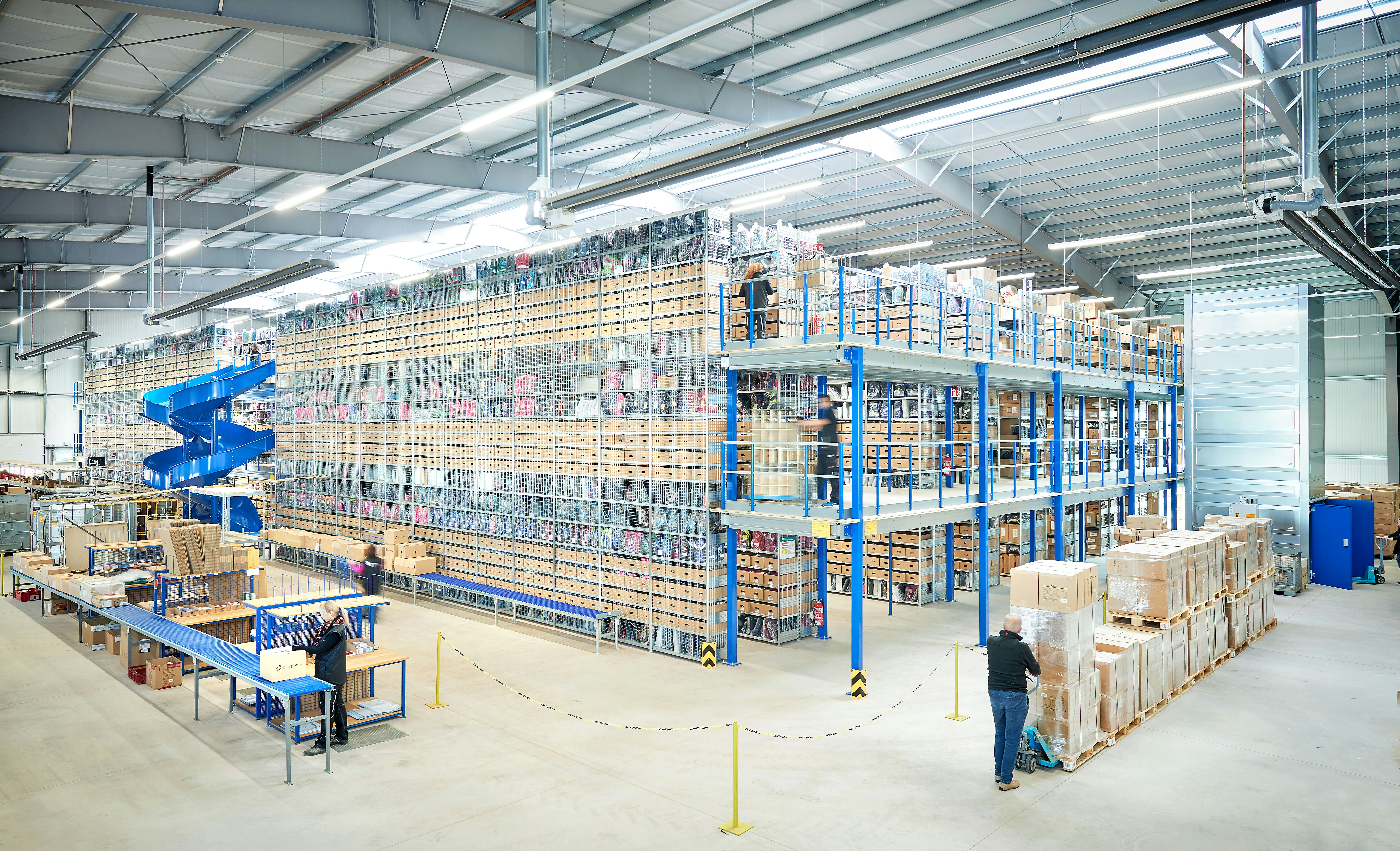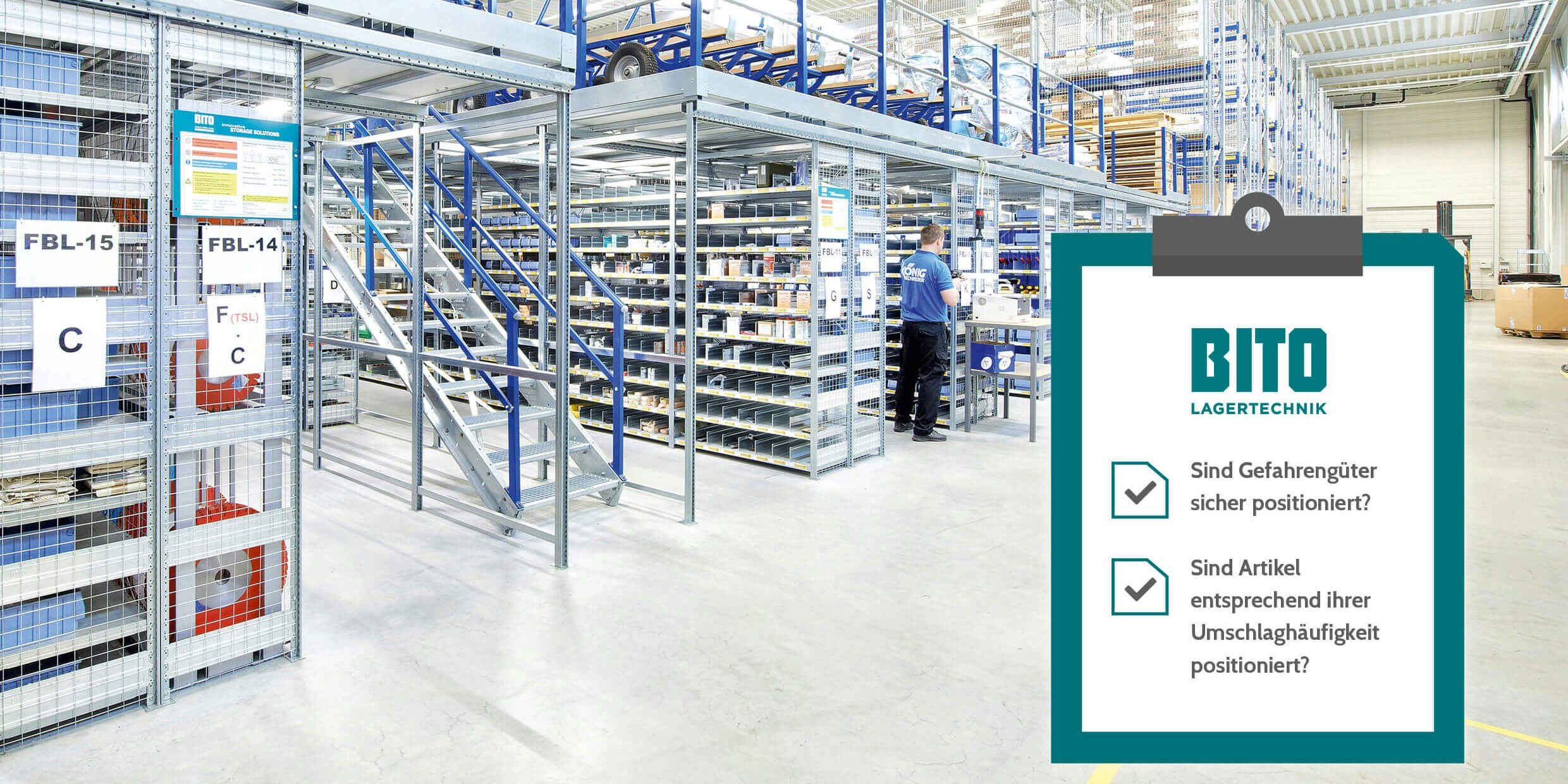What is storage technology?

Warehouse technology encompasses all methods, equipment and aids used for the storage of goods and materials in logistics. The aim of warehouse technology is to make storage as efficient, safe and economical as possible. This includes the planning, execution and control of storage in order to ensure optimum use of storage space, minimise storage costs and guarantee the quality and availability of the stored items. Warehouse technology includes various components and systems, such as storage racks and shelving systems, conveyor technology, warehouse management systems (WMS), picking technology, packaging technology and security systems. The internal processes relating to the movement of materials and goods on company premises are known as intralogistics.
Importance of warehouse technology for companies
Warehouse technology is a central aspect of corporate logistics. It acts as a link between the areas of procurement, production, distribution and disposal and is of crucial importance for the efficient flow of materials. Warehouse technology plays a central role for companies by making a significant contribution to increasing efficiency and optimising warehousing processes. By using advanced storage systems, companies can maximise their storage capacity, speed up the turnover of goods and minimise storage costs. Modern storage systems enable fast and precise handling of goods, from receipt to storage to delivery. Automated systems such as conveyor belts, stacker cranes and robotics shorten processing times and reduce human error, which increases the overall efficiency of the warehouse. The use of compact warehouses such as shuttle warehouses, mobile racking or flow racking allows storage space to be optimally utilised. Effective inventory management is essential for maintaining smooth operations. Warehouse management systems (WMS) enable precise monitoring and control of stock levels in real time. This enables companies to avoid overstocking and ensure the availability of products. Automated systems reduce the need for manual labour, resulting in lower labour costs. In addition, efficient warehousing can help to minimise damage to goods and reduce the need for emergency orders, which also lowers costs. Ergonomically designed workstations and the automation of processes can reduce the risk of workplace accidents and work-related illnesses. Modern warehouse technology also offers flexibility and scalability and therefore the ability to adapt to changing market conditions. Companies are under increasing pressure to improve their environmental footprint. Efficient warehouse technology can help to reduce energy consumption, for example by using electrically powered vehicles in the warehouse instead of diesel-powered ones, and minimise CO2 emissions.
Types of storage technology and their functions
Shelving and shelving systems
Even if the option of block storage without racking exists, manual solutions such as shelving and automated shelving and racking systems or storage racks are increasingly being used. These shelving and racking systems not only utilise the storage space perfectly, are adapted to the goods to be stored, offer good access to the goods and the option of fast order picking, but can also be automated using storage and retrieval machines (SRMs) or shuttles, for example, and can also be easily scaled. Storage such as shelving racks, for example, are perfect for piece goods to which easy access must be guaranteed. Flow racks are particularly suitable for fast and medium movers. Pallet racking is designed for storing large quantities of palletised goods. A wide range of variants are available here, such as the standard pallet racking variant, drive-in and mobile racking, pallet flow racking (PDS) and automated pallet racking with RGB or shuttles. There are also multi-tier systems (MGA) and platforms, special racking for long goods, flow racks for general cargo and automated small parts warehouses (AKL).
Conveyor technology
By using various conveyor systems such as roller conveyors, belt conveyors and automated transport vehicles, companies can increase their productivity, optimise the use of space and increase the flexibility of their operational processes. In addition, the integration of conveyor technology into modern WMS enables seamless and efficient control of the entire material flow, from delivery through to despatch. Typical products include manual roller conveyors, extendable scissor roller conveyors, various segments and curves for roller conveyors as well as complete shelves equipped with roller conveyors. The range also includes manual lifting and hand trolleys as well as hydraulic stackers for various applications. BITO is also expanding its range to include automated solutions, including live storage racking with drive rollers and the track-guided, automated container transport system LEO transporter which enables efficient material movement within warehouses and production facilities.
WMS
A warehouse management system (WMS) is used to organise product quantities and storage locations, which is why it can also be referred to as an inventory management system. It can also take on tasks such as controlling transport systems, for example conveyor technology. In contrast, a warehouse management system (WMS) is much more comprehensive and complex. It maps the entire material and information flow within a company. A WMS receives orders from higher-level systems, such as an enterprise resource planning (ERP) or merchandise management system, manages them in a database and, after careful optimisation, forwards them to the connected conveyor technology for execution. It takes over the control, monitoring and optimisation of complex warehouse and distribution processes. A WMS integrates the basic functions of a WMS and expands them with additional features, including advanced methods for monitoring the system status and various operating and optimisation strategies.
Order picking technology
Picking orders is one of the most time-consuming and costly activities within a company. A picking system comprises the picking warehouse with the corresponding articles, the means of transport used, the personnel and the actual picking orders. Its central function is to control and organise the flow of materials and information. This function can be managed in various ways: manually, with employees going directly to the goods, semi-automatically, with goods being transported to the employees, or fully automatically through the use of picking robots. The optimisation of the picking process and the seamless integration of material and information flows offer great potential for rationalisation. Various technological solutions are used here, including WMS, means of transport such as forklift trucks, picking trolleys, stacker cranes and shuttles, conveyor technology and various picking techniques such as pick-by-voice, barcode scanners and RFID technology. BITO is very familiar with order picking processes and has many solutions in its portfolio, such as order picking containers, order picking trolleys, staging racks as well as unit load and pallet flow racking, many of whicj are available online.
Safety systems, collision and rack protection
Unfortunately, serious accidents can easily occur in warehouses and and companies have a duty to reduce the risk of damage or personal injury. Heavy industrial trucks in particular can cause even large racking systems to collapse by ramming. This often results not only in major damage to property, but also serious personal injury. Certain rack protection and impact protection measures are required by law, others are optional. Examples of rack protection systems include corner and edge protection profiles, solid surface protection, impact protection bars, safety markings and barrier systems to separate traffic and work areas. You can buy products for collision and rack protection online in the BITO webshop.
Advantages and challenges of warehouse technology
The use of modern storage systems and warehouse equipment offers many advantages, such as increased storage capacity through more efficient use of space, optimised warehouse processes that speed up the flow of goods and reduce throughput times, as well as a significant reduction in costs through the automation of work processes. Furthermore, improved inventory management enables precise control and monitoring of stock levels, which prevents overstocking and ensures product availability. Occupational safety is increased through the use of automation technologies and ergonomic solutions. This minimises the risk of accidents at work. However, these benefits also come with challenges, such as high initial investments, which can be a barrier for smaller companies. There is also a high level of technical complexity and corresponding maintenance requirements that call for specialised expertise. The need to adapt existing processes and train employees can be just as demanding. In addition, the dependence on technological systems increases the risk of operational disruptions in the event of technical failures and raises questions about data security and environmental protection. Despite these challenges, the introduction of modern warehouse technology remains a crucial step for companies to increase their efficiency and competitiveness in a dynamic market environment.
The role of innovation in warehouse technology
The role of technology in warehouse technology is of fundamental importance and has developed over time into a central element for optimising and increasing the efficiency of warehouse processes. Technological innovations make it possible to automate, simplify and accelerate warehouse processes, leading to a significant improvement in performance and efficiency. Examples include increasing digitalisation and automation, including through Industry 4.0, the exponentially increasing use of artificial intelligence (AI), the Internet of Things (IoT) and data analysis, digital twins, augmented reality (AR), RFID and technologies for optimising supply chains in order to minimise CO2 emissions.
How can I benefit from optimised storage technology?
As described above, modern warehouse systems and warehouse equipment offer many advantages, but also present companies with challenges. Due to increasing competition and the high demands of online retail, Industry 4.0, digitalisation and automation are no longer an option. Basically, the aim is to increase efficiency, reduce costs and, last but not least, increase customer satisfaction. Challenges can and must be overcome. High initial investments can be minimised by initial partial automation, for example, through the use of automated guided vehicles (AGVs), cobots, automated shelving, etc. However, it is often advisable to implement a WMS, which has many advantages, such as the implementation of perpetual inventory. In principle, however, a long-term automation plan for the warehouse and warehouse technology should be drawn up right from the start. BITO offers products, complete solutions and services for warehouse technology.


